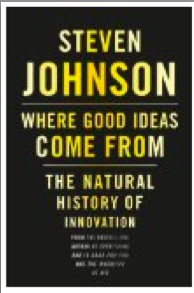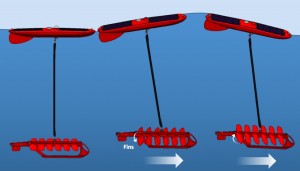“Any intelligent fool can make things bigger, more complex, and more violent. It takes a touch of genius — and a lot of courage — to move in the opposite direction.” — Albert Einstein
In my last post I tried to describe, within the context of Kevin Kelly’s book, What Technology Wants the opportunity and challenge of developing the equivalent of “autonomous virtual” assistants pushing forward near real-time information most relevant to critical command & control decisions. That we will achieve this over the decades to come, I have little doubt. In our world of ubiquitous information, the more important question becomes can or will our Nation embrace paradigm-shifting technologies faster than our future adversaries?
 One of my favorite recent books is Where Good Ideas Come From; The Natural History of Innovation by Steven Johnson. Like Kevin Kelly, Steve is fascinated by how we as humans progress using our ability to extrapolate new ways to do things from a background of how we currently do things. In this book, Johnson dispels the popular myth that ideas come from a smart person isolated in a pristine place, with a clear mind, generating great new ideas. He argues the opposite! Research shows that more ideas emerge the more we humans are connected, be that in cities, across professional societies, or across new innovations of the internet such as Facebook and Twitter. Interestingly, according to Johnson’s research, crowded cities actually improve our ability to generate ideas:
One of my favorite recent books is Where Good Ideas Come From; The Natural History of Innovation by Steven Johnson. Like Kevin Kelly, Steve is fascinated by how we as humans progress using our ability to extrapolate new ways to do things from a background of how we currently do things. In this book, Johnson dispels the popular myth that ideas come from a smart person isolated in a pristine place, with a clear mind, generating great new ideas. He argues the opposite! Research shows that more ideas emerge the more we humans are connected, be that in cities, across professional societies, or across new innovations of the internet such as Facebook and Twitter. Interestingly, according to Johnson’s research, crowded cities actually improve our ability to generate ideas:
“…despite all the noise and crowding and distraction, the average resident of a metropolis with a population of five million people was almost three times more creative than the average resident of a town of a hundred thousand.”
 Johnson makes a good case that ideas grow faster as we diversify our interactions and our exposure to people working across a broad swath of communities and technologies. His case is easy to accept when we think about our own human actions. I can see on a daily basis that I am better at extrapolating an idea from what I am exposed to, than I am at inventing an idea outside the box of thoughts I am carrying around in my head.
Johnson makes a good case that ideas grow faster as we diversify our interactions and our exposure to people working across a broad swath of communities and technologies. His case is easy to accept when we think about our own human actions. I can see on a daily basis that I am better at extrapolating an idea from what I am exposed to, than I am at inventing an idea outside the box of thoughts I am carrying around in my head.
Considering Johnson’s theses, that ideas flourish better in noisy diverse environments, causes me to wonder at the wisdom of pushing our National Security systems acquisition activities behind more curtains of security. In an anti-idea sense, we limit the access to modern tools of productivity behind these security curtains, for fear of cyber threat compromise. Within these closed security enclaves we are hoping to invent our future high technology weapon systems faster and better than our would be adversaries who are freely roaming the noise and crowding of urban cities and the growing ubiquity of the web! I prefer to align with Johnson’s argument:
“If there is a single maxim that runs through this book’s arguments, it is that we are often better served by connecting ideas than we are by protecting them.”
Recently I have been helping my good friend and colleague, Bill Vass, with his new challenge as the CEO of the start up company Liquid Robotics.  This Company is interesting on many levels, not the least of which is that they are building tools to help use our vast ocean resources more effectively. After seeing in action the unmanned surface vehicle, they call Wave Glider®, one can easy understand how it converts ocean waves into unlimited mobility. As you can see from the below diagram, or this video, vertical wave motion at the surface float is converted into forward thrust in the below surface sled. Like the wheel, the idea converting waves into forward mobility is amazingly simple when we see how it works, but until now we haven’t had this technology in our human toolkit.
This Company is interesting on many levels, not the least of which is that they are building tools to help use our vast ocean resources more effectively. After seeing in action the unmanned surface vehicle, they call Wave Glider®, one can easy understand how it converts ocean waves into unlimited mobility. As you can see from the below diagram, or this video, vertical wave motion at the surface float is converted into forward thrust in the below surface sled. Like the wheel, the idea converting waves into forward mobility is amazingly simple when we see how it works, but until now we haven’t had this technology in our human toolkit.
 When one considers that Wave Gliders® are capable of freely roaming the 72 percent of our planet covered by water, while sensing and reporting on the status of at-sea oil and gas wells, off-shore wind generators, undersea telecommunication cables, fisheries, regional and port security, and ocean weather, it quickly become obvious that these Wave Gliders® are an idea that reaches the level of a paradigm shift! By using a combination of wave power for mobility plus solar power for communications and sensor power, these low cost devises are capable of providing the distributed persistence needed to redefine the transparency of our vast oceans and all that they represent.
When one considers that Wave Gliders® are capable of freely roaming the 72 percent of our planet covered by water, while sensing and reporting on the status of at-sea oil and gas wells, off-shore wind generators, undersea telecommunication cables, fisheries, regional and port security, and ocean weather, it quickly become obvious that these Wave Gliders® are an idea that reaches the level of a paradigm shift! By using a combination of wave power for mobility plus solar power for communications and sensor power, these low cost devises are capable of providing the distributed persistence needed to redefine the transparency of our vast oceans and all that they represent.
At the National Security level, the issue now becomes whether we will embrace the paradigm shift of distributed ocean transparency as a tool to protect global commerce and progress, or miss the possibilities provided by this new technology as we continue to expend our energies and budgets on traditional undersea technologies.
… The interesting thing about new ideas is that once shared, they cannot be unshared!!
Post blog note: Given that I am proving that blogging does not fit into by daily discipline more than a few time a year, I have decided to take my son’s advice and work harder to embrace the technology and opportunity of Twitter. I will attempt to post short thoughts, ideas, or learning’s on twitter at my address of: @marvlangston
Steve Johnson on Twitter @stevenbjohson
Kevin Kelly on Twitter @kevin2kelly

On the topic of sharing ideas….
Somebody coined the term Government Open Source Software (GOSS) which I heard for the first time last week (although it has been around for longer). It turns out there are a handful of software projects in DoD which are working hard to break down the barriers to sharing knowledge and development effort among distinct departments and organizations by sharing their code outright, and allowing members of the community to drive requirements and contribute back code (with direct access to the project’s main repository in some cases).
Beyond opening up communication among development teams within DoD, there are additional efforts by GOSS teams to make certain projects available outside of DoD as Free Open Source Software (FOSS) projects, which would offer non-DoD contractors to use the software and contribute back… offering opportunities to get feed back from developers in other industries.
I was very happy to hear people were not just thinking about this, but had actually made some progress down that path.
Brian,
Thanks for the useful update on government open source activity. I would love to learn more relative to the areas of development and what is being developed. thanks, marv
I essentially created the GOSS process, along with some outstanding colleagues at ODNI and NSA. (We’re getting an Honorable Mention this week from Government Computer News.) Folks in the DoD or IC can read more about it at the OWF GOSS Intellipedia page.
The specific problem that we was trying to address was that some smart folks at NSA had written some cool software and were giving it away to other DoD & IC agencies. Many of those agencies were making local enhancements, essentially “forking” the codebase, without visibility into what the others were doing, and increasing rework and incompatibility with each new release. The GOSS process gives stakeholders access to the unvarnished source code, and a process to submit changes back to the community. It is an attempt to set basic ground rules about how to collaborate the way the OSS community does, and establish the necessary people, process and technology to make it happen inside the government. This approach has been endorsed within the ODNI at a pretty senior level.
One of the foundational goals of the OWF GOSS board is to get to point when we can release outside the government as “true” OSS. We couldn’t do this from the start because we had (Intelligence) community members who have some cultural issues to work through, but we’ll get there soon.
Amazingly, we’re getting help from the most unlikely place: the Senate Armed Services Committee included a small provision in the 2012 NDAA (Section 923) that would effectively direct the DoD to release the software in question as OSS.
Also interestingly, I had two lengthy telecons today to provide GOSS consulting to other projects that want to adopt a similar model. Hopefully
Dan
PS. Great to hear that Bill landed on his feet. I lost track of him after the Oracle buyout. I’ve been dreaming about building “Unmanned Maritime Systems” for years now, and it’s fabulous that Bill is doing it!
Dan, I agree that the positive movement of these IC efforts is potentially revolutionary for the National Security future. Thanks for the great work and the comments for all to share. marv
This is exactly why many innovative companies (including MS) went to the open campus feel to their offices. Ideas are not some eureka moment baked in isolation. The seed for some of those concepts are most likely the result of applying collective intelligence. Our adversary knows this but lacks much of the spirit of innovation we collectively share. Core to this innovation however is creating a trusted sharing environment. There are barriers both in government and industry as well as between the two that inhibit such collaboration. We need to leverage our existing relationships to build the communities of practice needed to forge innovation.
My two cents.
Steve Lines.
Steve, I find it very interesting that our NS community fails to find the correlation between commercial innovation and the need for innovation within the NS community. marv
Re: the security vs innovation argument… We have been struggling with this for years and the struggle will continue for years to come. What we need is the ability to innovate within a security structure that is agile (and, unfortunately, clairvoyant) enough to ensure that we don’t “give away the store” in the process. Given that, at least on the technical and operational levels (i.e., excluding unfettered futurists like Gene Roddenberry), we are generally lousy futurists, we most often default to maximum security to cover our lack of a reliable crystal ball. So, we retard gains in innovation, both near and long term, in the very understandable interest of protecting ourselves from what we don’t (and can’t) know. Like most things federal, the discussion as evolved into a debate between the extremes: no access vs open access. The answer is somewhere in between, tailored to the issue being addressed. The good news, I suppose, is many more people can make money selling many more books on this subject…
Now on to more pleasant and less intractable thoughts… My wife and I had the pleasure of attending the Liquid Robotics christening ceremony for the four wave gliders that have now been launched on their epic journeys in the Pacific (liquidr.com/pacx): Piccard Maru & Fontaine Maru will head from the California coast to Japan and Bengamin & Papa Mau will head to Australia. It was a great effort by the Liquid Robotics team and a fitting send-off for the four pioneer robots. The next day, I spent a few hours at the Liquid Robotics facility in Sunnyvale. I toured the plant and met with some of the people. This concept (now reality) is a giant step forward in fundamental innovation; its simplicity as well as its clear potential to fulfill the requirements for persistent presence in both commercial and military applications are very exciting. The process and the product represent the best of platform innovation in the “open” that can be tailored to many applications, both open and less so. It was a wonderful couple of days.